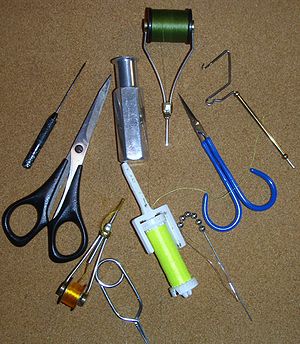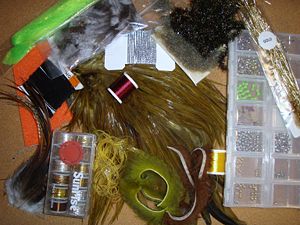Tools
The fly tying process benefits from the fly tyer employing the proper tools. According to Skip Morris, a professional fly-tyer, there are several tools essential to the creation of a properly tied fly. He lists essential tools as being: a vise to hold the hook of the fly to be tied, as well as bobbins, magnifying glass for delicate work, hackle pliers, hackle gauges, lights, hair stackers, and scissors. Other optional tools are pliers, toothpicks, bodkins, dubbing twisters, blenders, floss bobbins, whip finishers, wing burners, and bobbin threaders.[12]
[edit]Materials
Fly tying material can be anything that is used to construct a fly on a hook. Traditional materials were threads, yarns, furs, feathers, hair, tinsels, cork, balsa and wire. Today's materials not only include all sorts of natural and dyed furs, hair and feathers but a wide array of synthetic materials. Rabbit, mink, muskrat, fox, bear, squirrel and other furs,deer, elk, moose hair and chicken, pheasant, turkey, duck, goose and partridge feathers were and still are commonly incorporated into
artificial flies. Neck and saddle hackle from chickens, so critical to many artificial fly patterns is being especially bred for fly tying to achieve superior performance and color. Synthetics have allowed fly tyers to replicate rare and sometimes illegal and endangered furs and feathers and well as create completely new types of flies. Synthetics such as rubber legs, plastic wings and transparent plastic cords, chenilles, and all sorts and colors of flashy materials that can be incorporated into wings and bodies of today's artificial fly are available to the 21st Century fly tyer. Whereas lead wire was the traditional method of weighting flies, today's weighting materials include glass, brass and tungsten beads and cones as well as lead materials. Silicone, epoxy, kevlar thread and other modern materials are being incorporated in artificial fly patterns regularly.[13][14]
artificial flies. Neck and saddle hackle from chickens, so critical to many artificial fly patterns is being especially bred for fly tying to achieve superior performance and color. Synthetics have allowed fly tyers to replicate rare and sometimes illegal and endangered furs and feathers and well as create completely new types of flies. Synthetics such as rubber legs, plastic wings and transparent plastic cords, chenilles, and all sorts and colors of flashy materials that can be incorporated into wings and bodies of today's artificial fly are available to the 21st Century fly tyer. Whereas lead wire was the traditional method of weighting flies, today's weighting materials include glass, brass and tungsten beads and cones as well as lead materials. Silicone, epoxy, kevlar thread and other modern materials are being incorporated in artificial fly patterns regularly.[13][14]
[edit]Hooks
The hook determines the basic size and shape of each fly and is generally an important part of any fly pattern description. Hooks come in a wide range of sizes, shapes, lengths, and weights, and the hook must be selected to complement the pattern being tied and the method by which it will be fished. Additionally, flies constructed for use in salt water are typically tied on corrosion-resistant hooks.
[edit]The fly pattern
The fly pattern is the recipe for any particularly named fly. In older literature, especially prior to the 20th century, fly patterns were referred to as dressings. The pattern specifies the size range and type of hook to be used, the materials to use including type, color and size, and in some cases specific tying instructions to achieve a particular effect or configuration. Fly patterns allow tyers to consistently reproduce any given pattern over time. A Light Cahill dry fly produced by one tyer will look remarkably similar to the same fly produced by a completely different tyer if the pattern is followed with reasonable accuracy with comparable materials. Patterns may also lay out alternatives for different materials and variations of the fly.
Fly patterns are usually found in fly fishing and fly tying literature and periodicals to include on-line sources. Although fly patterns do provide some consistency, different writers may publish patterns that contain small to moderate differences across pattern descriptions for the same fly. In many cases, the greatest differences are in tying technique instead of form, color and materials. Fly patterns may or may not have an image or drawing of the finished fly to guide the fly tyer. Historically, fly patterns have been included in texts that discuss fishing a particular genre of fly, fly fishing technique or fly fishing for specific species or genre of gamefish. There are however, texts that are pure fly pattern and tying references with little or no instruction on how to fish them.
[edit]Parts of an artificial fly
Salmon flies have historically been the most complex and gaudy of artificial flies. Texts describing fly tying techniques often use an image of a salmon fly to describe all the parts of an artificial fly. The parts described below are typical.
Key to Parts of Salmon Fly Image
|




